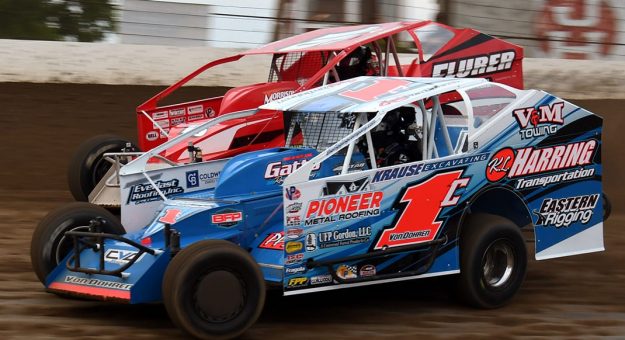Rules-wise, it’s a unique environment. The Pennsylvania definition of a 358 modified has a compression limit of 10.5:1. The rulebook requires a spec cylinder head, a basic Brodix aluminum casting. You can’t grind, weld or blend the heads. Porting is prohibited. Under the rules, it’s effectively a spec engine, running $18,000 to $22,000, with a Holley 750 carburetor. For the weekly racers, it saves money compared to going with a big-block engine and chasing a major touring series.
“A big-block is $50,000,” Von Dohren said. “To build a new car, you’re talking $34,000 with no shocks and no wheels or tires. You put a $50,000 engine in there and get it to the race track and you’re looking at well over $100,000, even with a somewhat average pickup truck and a trailer. It’s a huge expense.
“When I ran East Windsor in New Jersey for a few years, you needed a unique car to run there. Now you need a unique car (for some of the touring series), at least as far as engines go. For one series, you basically need a late model engine that’s legal there, a 440-inch small-block. So now you’ve got six, eight, 10 races a year that you need a $50,000 engine to run.
“They’re good engines, but anything can happen, so you better have two of them,” Von Dohren added. “I don’t know that it’s a bad thing; it just makes it hard to run a lot of races with your own stuff. You need a hell of a lot of money. And we don’t have one of those 440-inch motors. You’ve got to pick a number and run what’s feasible.”

For the uninitiated, Grandview Speedway is a knife fight that doesn’t involve blades. It’s a third-mile dirt track with steep banks and an unforgiving surface. The pit area is packed on a Saturday night. Top runners can find themselves deeply handicapped in the field and passing inevitably involves contact. Cars get bent and tempers can sizzle. Getting to the front, much less being in a position to win, can be both physically rough and highly frustrating.
“Racing at Grandview has made me so much better as far as being a driver goes,” Von Dohren stated. “You’ve got to be able to see what’s happening five, maybe six rows up in front of you. Your vision is important. You have to be able to anticipate things before they actually happen. You have crashes pretty much anywhere you go, anymore. Grandview isn’t the villain anymore as far as wrecking goes, though it probably was in the past.
“The cars are better. It’s harder to spin out,” Von Dohren continued. “Years ago, when you had the old homemade cars, they didn’t handle. Now everybody’s buying the same car and motor that I’m buying. You might still have terrible accidents, but it’s not like you’re getting three of them a night anymore. There’s a lot of respect. It’s kind of like going down a highway, where you know there are certain times when you don’t just pull out.”
Despite all the success, Von Dohren keeps things in perspective.
“It’s 300 wins,” he said. “When I think about that and then think about Brett Hearn having nearly a thousand, it’s like, ‘I suck.’ It’s amazing what those guys up north (mainly New York) can do. Sometimes, it’s not about the money. It’s about doing a good job.”
The North Star in Von Dohren’s constellation is Pioneer Pole Buildings, his main backer for more than a decade, plus K.L. Harring Transportation and Big Dave, as in Dissinger, his Big Diamond car owner.
Von Dohren knows the clock’s ticking on his career. He’s got a family, the family farm, and like all of us, a life.
“I’d love to run more races but I can’t do it at 57, and financially, it’s tough, so you pick and choose,” he mused. “You pick tracks you run better at. For some reason, I struggle over at New Egypt in New Jersey. So, nothing against those guys, I just don’t go. If you really want to do this, there are a lot of variables. Do you want to run Grandview? The Super DIRT Series? Brett Deyo’s series (Short Track Super Series)? A crate sportsman? There are lots of options to talk about if you really want to do this.
“Would I do it again? Yes,” the man from Oley Township declared. “My family’s been great, even when I ventured away. My son, Jared, is 26. Probably 17 years ago, I bought him a set of clubs, and said, ‘Go golfing.’ He loves it. He’s a good kid, out on the course every day he can.”
